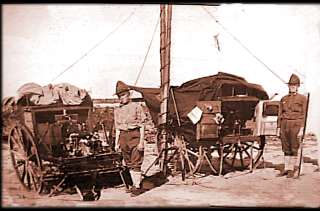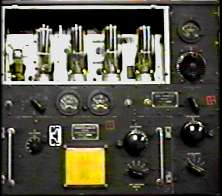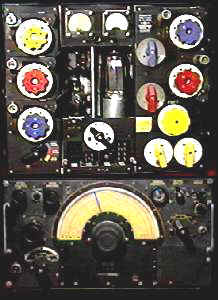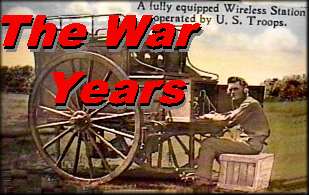 World War I Signal Corps
operators did not have an easy job at the front. Each location required the unpacking of
equipment from several wagons followed by the erection of antenna masts and the managing
of large generators required to power the spark transmitters. World War I Signal Corps
operators did not have an easy job at the front. Each location required the unpacking of
equipment from several wagons followed by the erection of antenna masts and the managing
of large generators required to power the spark transmitters.
It took years for Marconi to convince the various arms of the military that Wireless
would benefit warfare. Prior to wireless, the only communications from the front was by
 wire telephone and from the air the only
solution was hot air balloons tethered with a telephone line to report enemy locations. wire telephone and from the air the only
solution was hot air balloons tethered with a telephone line to report enemy locations.
This QRP Marconi Spark transmitter was used by the Royal
Air force recognizance aircraft
During World War I.
Equipped only with a one of these transmitters (no receiver) the radio operator would
transmit the location of the enemy in Morse Code and assist the gunnery officers site in
enemy targets.
 This HRO receiver look-a-like was
captured by the Americans from the Japanese during the Second World War when the US retook
the Aleutian Islands off Alaska. This HRO receiver look-a-like was
captured by the Americans from the Japanese during the Second World War when the US retook
the Aleutian Islands off Alaska.
 The
dial mechanism is the first giveaway to the radios origin. The US Navy sent the radio to
the National Corporation for examination. After extensive testing, National reported the
receiver met the same specifications of their original HRO. The
dial mechanism is the first giveaway to the radios origin. The US Navy sent the radio to
the National Corporation for examination. After extensive testing, National reported the
receiver met the same specifications of their original HRO.
We believes this Japanese model is the last
surviving operational unit.
The BC375
was a versatile transmitter developed in the late '30s and saw service in the B17, B24,
B25 and B26 bombers.

This BC375-E Serial Number 60946 was made by General
 Electric. The frequency range was
150 kHz to 21000 kHz using various Tuning Units. This transmitter and matching TU8 tuning
unit covered 6200-7200 kHz. Using three 211 tubes in the final the BC375-E produced 840
watts of DC input on AM and 600 watts on CW. It was also capable of MCW operation. The
companion receiver to the BC375 was the BC348. Electric. The frequency range was
150 kHz to 21000 kHz using various Tuning Units. This transmitter and matching TU8 tuning
unit covered 6200-7200 kHz. Using three 211 tubes in the final the BC375-E produced 840
watts of DC input on AM and 600 watts on CW. It was also capable of MCW operation. The
companion receiver to the BC375 was the BC348.
The
AR1154 transmitter (top unit with multi colour knobs) and the AR1155 receiver (bottom
unit) were used during W.W.II in the British built Lancaster bomber.
The AR1155 receiver was popular amongst Radio Amateurs after the war many of which still
survive today. However the AR1154 transmitter was not a popular unit being used mainly for
parts. This has resulted in complete AR1154's being quite rare.
|
[ Top
] |
Last
updated
November 10, 2011
©
1998 - 2004 Hammond Museum of Radio
|
|
|


 World War I Signal Corps
operators did not have an easy job at the front. Each location required the unpacking of
equipment from several wagons followed by the erection of antenna masts and the managing
of large generators required to power the spark transmitters.
World War I Signal Corps
operators did not have an easy job at the front. Each location required the unpacking of
equipment from several wagons followed by the erection of antenna masts and the managing
of large generators required to power the spark transmitters.  wire telephone and from the air the only
solution was hot air balloons tethered with a telephone line to report enemy locations.
wire telephone and from the air the only
solution was hot air balloons tethered with a telephone line to report enemy locations.  This HRO receiver look-a-like was
captured by the Americans from the Japanese during the Second World War when the US retook
the Aleutian Islands off Alaska.
This HRO receiver look-a-like was
captured by the Americans from the Japanese during the Second World War when the US retook
the Aleutian Islands off Alaska.  The
dial mechanism is the first giveaway to the radios origin. The US Navy sent the radio to
the National Corporation for examination. After extensive testing, National reported the
receiver met the same specifications of their original HRO.
The
dial mechanism is the first giveaway to the radios origin. The US Navy sent the radio to
the National Corporation for examination. After extensive testing, National reported the
receiver met the same specifications of their original HRO. 
 Electric. The frequency range was
150 kHz to 21000 kHz using various Tuning Units. This transmitter and matching TU8 tuning
unit covered 6200-7200 kHz. Using three 211 tubes in the final the BC375-E produced 840
watts of DC input on AM and 600 watts on CW. It was also capable of MCW operation. The
companion receiver to the BC375 was the BC348.
Electric. The frequency range was
150 kHz to 21000 kHz using various Tuning Units. This transmitter and matching TU8 tuning
unit covered 6200-7200 kHz. Using three 211 tubes in the final the BC375-E produced 840
watts of DC input on AM and 600 watts on CW. It was also capable of MCW operation. The
companion receiver to the BC375 was the BC348.